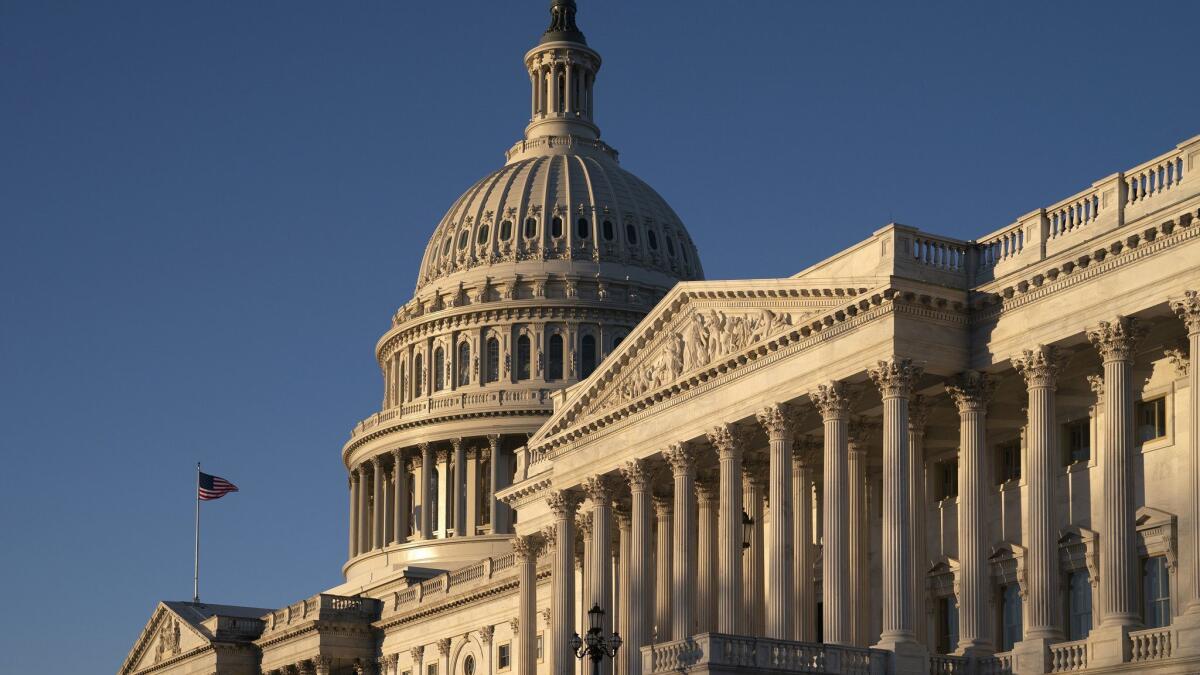U.S. federal deficit has ballooned 77% so far this fiscal year

The federal budget deficit ballooned rapidly in the first four months of the fiscal year amid falling tax revenue and higher spending, the Treasury Department said Tuesday, posing a new challenge for the White House and Congress as they prepare for a number of budget battles.
The deficit grew 77% in the first four months of fiscal 2019 compared with the same period last year, Treasury said.
The total deficit for the four-month period was $310 billion, Treasury said, up from $176 billion for the year-earlier period.
“It’s big tax cuts combined with big increases in spending when they already had big deficits,” said former Senate Budget Committee Chairman Kent Conrad (D-N.D), whose time in the Senate ended in 2013. “So guess what, it’s craziness!”
When Republicans seized control of the House of Representatives during the Obama administration, lawmakers and White House officials embarked on a number of strained negotiations to try to reduce the gap between spending and tax revenue. During the Trump administration, there have not been any similar discussions, and President Trump has largely pushed for an agenda of tax cuts and spending increases that has grown the deficit markedly.
Tax revenue for October 2018 through January 2019 fell $19 billion, or 2%, Treasury said. It noted a major reduction in corporate tax payments over the first four months of the fiscal year — a decline of nearly 25%, or $17 billion.
As part of the 2017 tax cut law, the tax rate paid by corporations was lowered to 21% from 35%.
Spending, meanwhile, increased 9% over the same period.
The biggest increases were for defense programs, which saw a 12% increase, and Medicare, which saw a 16% increase.
The Congressional Budget Office has projected that the deficit this year will reach nearly $900 billion because the government spends so much more money than it receives in revenue.
Next week, the White House is expected to propose a new budget plan for the fiscal year that begins in October, and Democrats are working on spending plans of their own. So far, there has been little effort to reconcile differences between both parties, and neither has shown much interest in addressing the widening budget deficit.
The White House plan will propose cutting a number of domestic programs by at least 5%, including environmental protection, education and foreign aid, according to Trump administration officials who have previewed some of the plans. It will also propose adhering to caps on military and non-military programs put in place several years ago, but it will simultaneously propose boosting defense spending in an uncapped program as a way to divert more money to the military.
Fiscal conservatives have criticized this type of maneuver in the past, but White House acting budget director Russ Vought wrote in an opinion piece last week that it was the best option for diverting more money to the military.
The ballooning deficit comes as interest rates are expected to begin rising, driving up the cost of borrowing money. The government is projected to spend $383 billion on interest payments for its debt this year, and that will rise to $581 billion in 2022, according to the Congressional Budget Office.
There has been a total breakdown in Washington over how to address the budget deficit. The White House has walled off the popular Medicare and Social Security programs from any proposed cuts, with Trump saying it would be too politically unpopular to pursue changes to programs used by tens of millions of Americans.
Democrats are also split over how to proceed. The ranks of fiscal hawks have dwindled, and a newer, vocal wing of the party has called for more deficit spending to finance social programs. Some in that wing argue the debt is less pressing than other social maladies, such as poverty or inadequate healthcare coverage, while others argue the debt is of little consequence at all.
Instead of trying to resolve their differences, the White House and some Democrats are seeking to make the 2020 elections a referendum on economic policy, suggesting neither side is looking to reach a compromise in the coming months.
But the White House and Congress must reach an agreement on a new spending package by Sept. 30 or face another government shutdown.
Policymakers must also reach an agreement by this fall on raising or suspending the debt ceiling, as the government will no longer be able to borrow money to cover many payments if Congress doesn’t act.
Lawmakers have not begun debating how to deal with the debt ceiling at all, even though the last temporary suspension ended March 1. The Treasury Department is now suspending certain payments and using delay tactics to allow it to continue funding operations to buy policymakers more time.
During the tax cut debate in 2017, the White House promised that slashing tax rates would end up creating more revenue because it would allow the economy to grow at a faster clip. Economic growth did pick up in 2018, but Democrats have said the growth will be short-lived. So far, the growth has not come close to the levels needed to offset the $1.5 trillion in tax reductions that were part of the legislation.
The federal government is now more than $22 trillion in debt, largely representing an accumulation of all the money it has borrowed to finance programs in past years. A deficit is the one-year gap between spending and revenue, and the debt is the total amount of money owed by the government.
The U.S. economy is still the strongest in the world, and investors have retained a healthy appetite for U.S. government debt because the country has never defaulted on its obligations. But high debt levels have caused financial crises in a number of other countries and forced major economic changes that have led to recessions, a phenomenon that some have warned could happen in the United States if steps aren’t taken.
Sen. James Lankford (R-Okla.) was bemoaning debt levels Tuesday a few hours before the Treasury Department reported the big increase in the deficit.
“If you take 22 trillion miles, total distance, you would fly from Earth to Pluto and back 3,081 times,” Lankford said on the Senate floor. “This is a heavy debt.”






